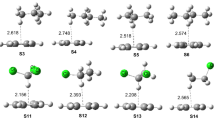Abstract
Within the framework of the one-electron MO perturbation method, a simple qualitative model has been developed for positional selectivity of free-radical substitution in the aromatic ring, with which the basic regiochemical trends can be predicted. The dominant trends in regioselectivity of homolytic aromatic substitution are determined by the polar (“philic”) character of the attacking radical and the symmetry of the regiocontrolling MOs are the frontier orbitals and the next (second) HOMOs and LUMOs. In situations in which the attacking radical is distinctly polar relative to the aromatic substrate (where the radical has a nucleophilic or electrophilic character) and the regiocontrolling MO is an orbital of the b1 type (C2v symmetry), ipso attack is possible, with subsequent ipso-ortho rearrangement. In the case of an ambiphilic attacking radical, this probability is very low. The effectiveness of the approach is illustrated in examples of the interaction of various free radicals with monosubstituted benzenes. In addition, other applications of the model are discussed.
Similar content being viewed by others
Literature cited
K. Fukui, Theory of Orientation and Stereoselection, Springer, Berlin (1975).
N. D. Epiotis, Theory of Organic Reactions, Springer, Berlin (1978).
I. Fleming, Frontier Orbitals and Organic Chemical Reactions, Wiley-Interscience, New York (1978).
S. V. Volovik, G. G. Dyadyusha, and V. I. Staninets, “Delocalization model of regioselectivity and reactivity of free radicals in reactions of addition to olefins,” Teor. Éksp. Khim., 23, No. 2, 135–148 (1987).
S. V. Volovik, G. G. Dyadyusha, and V. I. Staninets, “Concept of polarity of free radicals in reactions of addition to olefins,” Teor. Éksp. Khim., 22, No. 5, 562–571 (1986).
M. J. S. Dewar, The Molecular Orbital Theory of Organic Chemistry, McGraw-Hill, New York (1969).
T. Kobayashi and S. Nagakura, “Photoelectron spectra of substituted benzenes,” Bull. Chem. Soc. Jpn., 47, No. 10, 2563–2572 (1974).
K. D. Jordan, J. A. Michejda, and P. D. Burrow, “Electron transmission studies of the negative ion states of substituted benzenes in the gas phase,” J. Am. Chem. Soc., 98, No. 23, 7189–7191 (1976).
S. V. Solovik, G. G. Dyadyusha, and V. I. Staninets, “Probability of ipso-ortho rearrangement in free-radical aromatic substitution,” Zh. Org. Khim., 18, No. 6, 1142–1146 (1982).
A. D. Baker, D. P. May, and D. W. Turner, “Molecular photoelectron spectroscopy. The vertical ionization potentials of benzene and some of its monosubstituted and l,4-disubstituted derivatives,” J. Chem. Soc., No. 1, 22–34 (1968).
K. D. Jordan and P. D. Burrow, “Studies of the temporary anion states of unsaturated hydrocarbons by electron transmission spectroscopy,” Acc. Chem. Res., 11, No. 9, 341–348 (1978).
M. K. Eberhardt and M. Yoshida, “Radiation-induced homolytic aromatic substitution. Hydroxylation of nitrobenzene, chlorobenzene, and toluene,” J. Phys. Chem., 77, No. 5, 589–597 (1973).
J. R. Shelton and C. W. Uzelmeier, “Homolytic aromatic cyclohexylation,” J. Am. Chem. Soc., 88, No. 22, 5222–5228 (1966).
W. A. Pryor, W. H. Davis, and J. H. Gleaton, “Polar effects in radical reactions. Homolytic aromatic substitution by methyl radicals,” J. Org. Chem., 40, No. 14, 2099–2102 (1975).
D. H. Hey, B. W. Pengilly, and G. H. Williams, “Homolytic aromatic substitution. 11. The phenylation of toluene, ethylbenzene, and isopropylbenzene,” J. Chem. Soc., No. 6, 1463–1475 (1956).
M. Kobayashi, H. Minato, N. Kobori, and E. Yamada, “Aromatic arylation with aryl radicals,” Bull. Chem. Soc. Jpn., 43, No. 4, 1131–1135 (1970).
R. A. McClelland, R. O. Norman, and C. B. Thomas, “Reaction of lead tetrabenzoate with some benzenoid compounds and comparison with those of dibenzoyl peroxide,” J. Chem. Soc., Perkin Trans., 1, No. 4, 570–572 (1972).
C. R. Jefcoate and R. O. Norman, “Electron spin resonance studies. Hydroxylation,” J. Chem. Soc. B, No. 1, 48–53 (1968).
D. C. Nonhebel and J. C. Walton, Free Radical Chemistry. Structure and Mechanism, Cambridge University Press (1974).
N. D. Epiotis, “A simple correlation of hyperfine splitting constants of radical ions and orientation in aromatic substitution reactions,” J. Am. Chem. Soc., 95, No. 10, 3188–3193 (1973).
V. N. Kondrat'ev (ed.), Chemical Bond Rupture Energies; Ionization Potentials and Electron Affinity [in Russian], Nauka, Moscow (1974).
S. C. Dickerman and G. R. Vermont, “Homolytic phenylation of benzene, naphthalene, and anthracene,” J. Am. Chem. Soc., 84, No. 21, 4150–4151 (1962).
D. D. Davis and F. Y. Ahmed, “Electron transference in homolytic aromatic substitution reactions,” Can. J. Chem., 48, No. 5, 1019–1020 (1970).
C. N. Camaggi, R. Leardini, M. Tiesso, and A. Tundo, “Homolytic aromatic substitution of heterocyclic compounds. 4. The arylation of thiophene,” J. Chem. Soc. B, No. 9, 1683–1687 (1970).
R. S. Becker and E. Chen, “Extension of electron affinities and ionization potentials of aromatic hydrocarbons,” J. Chem. Phys., 45, No. 7, 2403–2410 (1966).
Author information
Authors and Affiliations
Additional information
Translated from Teoreticheskaya i Éksperimental'naya Khimiya, Vol. 23, No. 4, pp. 407–414, July–August, 1987.
Rights and permissions
About this article
Cite this article
Volovik, S.V., Dyadyusha, G.G. & Staninets, V.I. Molecular orbital model of regioselective free-radical aromatic substitution. Theor Exp Chem 23, 380–386 (1988). https://doi.org/10.1007/BF00536354
Received:
Issue Date:
DOI: https://doi.org/10.1007/BF00536354




